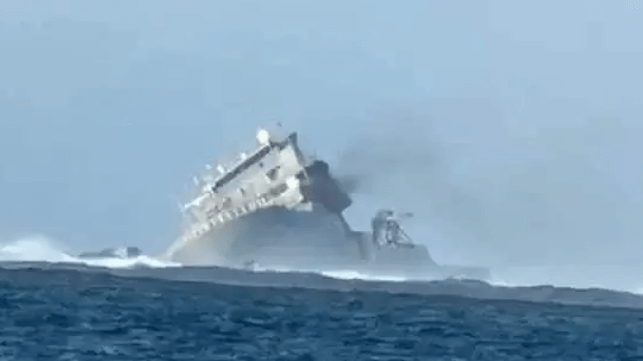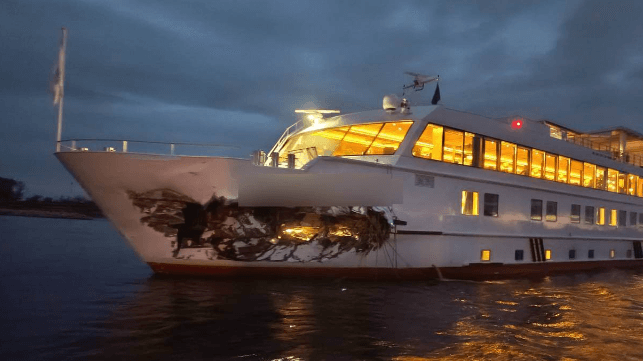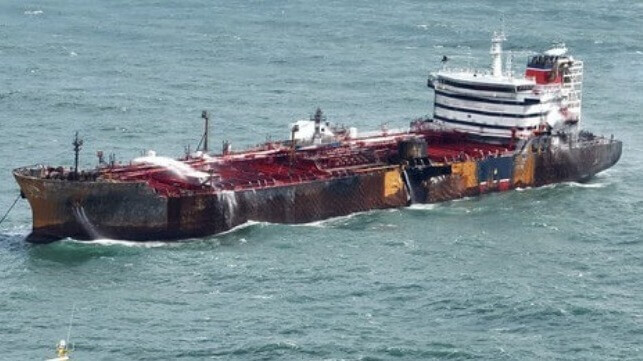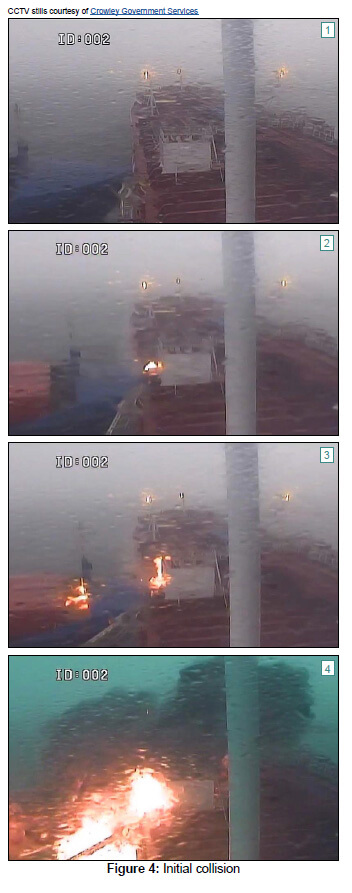New Zealand Court of Inquiry Identifies Training in Loss of Survey Vessel

The Royal New Zealand Navy released the final results of its Court of Inquiry into the shocking October 2023 loss of its survey vessel HMNZS Manawanui, the first vessel lost by the Navy since World War II. While the preliminary report released in November 2024 identified human error issues including failing to disengage the autopilot, the final report delves deeper to identify the underlying issues that they believe contributed to the loss of the vessel.
The interim Court of Inquiry focused on the direct issues, and it put the blame squarely on mistakes made by the crew. Failing to turn off the autopilot, the bridge crew attempted to maneuver the vessel. When the vessel did not respond they failed to check if they had manual control with it taking more than 10 minutes to regain control. The vessel however had grounded and the following morning after the 75 people on board were rescued the ship foundered.
In the final report, the court identified 12 additional issues that it says contributed to the grounding and sinking. Key among them were training issues and the qualifications of the ship’s personnel, as well as planning, instructions and procedures, supervision, haste, leadership, distraction, and interruptions. All these factors they believe made the loss more likely.
The court thanks the officers and crew of the vessel recognizing their braveness as well as their willingness to provide detailed testimony. The result was a 120-page report that was released online for public review.
“The Court found deficiencies in the training and qualifications of key ship’s personnel involved in the incident, risks related to the survey task were not sufficiently identified, discussed, and mitigated, and instructions or procedures were lacking,” said the Court of Inquiry president Commodore Melissa Ross. It also found leadership was inadequate in some areas, supervision was not at expected levels, and time pressure influenced the way the survey task was conducted.
Chief of the Navy Rear Admiral Garin Golding accepted the report acknowledging that it illustrated a gap between work as imagined on shore by command and work as done on the vessel.
“Fundamentally we need to do things differently. We need to adapt to new technologies, change the way we approach what we do, and find new ways to continue to deliver on what is expected of us,” he said.
The Court issued nine recommendations ranging from risk management to training. It cited the process around orders, instruction, and procedures as well as the experience of the crew.
Admiral Golding said the Navy has already moved forward in some areas, such as reviews of risk management, oversight, and documentation. He said among the audits was a review of the state of training. However, he recognized that some of the issues would be more complex and time-consuming to resolve.
“Ultimately, there are a range of issues, including the lack of commonality across the fleet, which means our people need to constantly adapt to new procedures each time they change ships,” said the admiral. He called for embarking on a transformation program that seeks to reform the approach to operating the Navy.
Two European River Cruise Boats Suffer Collisions in One Week

Two European river cruise boats were involved in separate collisions over the past week, one on the Rhine near Duisberg and another near Szczecin, Poland.
Collision on the Rhine damages two vessels
On Saturday, a Dutch river cruise vessel collided with a Dutch inland cargo vessel near Voerde-Spellen, Germany, just downriver from Duisberg on the Rhine.
Shortly after 0300 hours on Saturday morning, the unnamed cruise vessel and unnamed cargo vessel collided mid-river. The port bow of the cruise ship was torn open, leaving a gaping hole measuring about 200 square feet in area. Remarkably, none of the 140 passengers and crewmembers on board were harmed, and no injuries were reported aboard the cargo vessel.
All of the hull damage was above the waterline, and both vessels remained able to transit safely. The cruise boat berthed in Wesel and disembarked its passengers for onward travel.
The Duisberg Water Police suspect that the cargo vessel may have caused the collision, and detained it for an inspection. The master was taken to the central station in Duisburg for blood alcohol level testing. Germany's Waterways and Shipping Authority is conducting a parallel investigation into the cause of the collision.
Collision on the Szczecin Lagoon
On Monday evening, nine people were injured in a collision between a river cruise vessel and a fuel barge in Poland's Szczecin Lagoon. The cause of the casualty is under investigation.
Near Chelminek Island, the cruise boat Junker Joerg collided with the fuel barge Argonaut, tearing a large hole in the Junker Joerg's port bow. The Argonaut sustained damage above the waterline, but no penetrations.
Both vessels made it to a safe pier at Szczecin under their own power. Initially, no injuries were reported, but when Junker Joerg reached port the crew called for an ambulance. Eight people had superficial injuries, a provincial medical service spokesperson told Polish agency PAP, and four medical teams responded to the scene. One 84-year-old woman sustained head and hip injuries, and she had to be hospitalized for evaluation.
An inquiry has been opened to determine the cause of the collision, and any evidence will be passed to Poland's State Commission for the Investigation of Marine Accidents.
UK Report Says Solong Did Not Have Lookouts Despite “Patchy” Visibility

The UK’s Marine Accident Investigation Branch released initial results from its ongoing investigation into the “very serious marine casualty” resulting from the containership Solong hitting the anchored tanker Stena Immaculate. While many of the details have already leaked in the media, it confirmed the now-arrested master of the Solong was alone on the bridge despite the presence of fog in the area and functioning with no more than approximately seven hours of sleep between watches.
The Portuguese-flagged containership was moving at a speed of 16 knots having departed the prior evening from Grangemouth, Scotland, and on a planned passage to Rotterdam following a route the ship had used in the past. The master of the containership, Vladimir Motin, was on the bridge when the ship departed around 2000 on March 9, handed over the bridge at around 2400 to the second officer, and returned to the bridge at 0700 to assume the watch. He was the lone watchkeeper, despite requirements for a lookout at night and in foggy conditions, a violation that MAIB has emphasized in previous collision reports.
“The visibility in the area north of the Humber light float was reported to be patchy and varying between 0.25 nautical miles (nm) and 2.0nm. Neither Solong nor Stena Immaculate had a dedicated lookout on the bridge. At 0947, Solong collided with the anchored Stena Immaculate’s port side on a heading (HDG) of 150° and speed over the ground (SOG) of about 16 knots (kts),” MAIB states in its interim report. It also says there was a slight swell of 1 meter.
Crowley responded to the report with a statement highlighting, “It is important to note that watch requirements for vessels at anchor are different from ships that are underway. The Stena Immaculate was operating in compliance with applicable watch-standing safety regulations and Crowley company policies for an anchored vessel. We are confident that the forthcoming comprehensive investigation report will clarify the facts and circumstances of the incident, demonstrating that Crowley exercised appropriate vigilance.”
The report states that the tanker’s second officer was on watch. Crowley says the officer began a 12-hour lookout shift just before midnight.
MAIB emphasizes in the report that the findings are preliminary and that the investigation into the accident is ongoing. It states among the factors it will be exploring are “the navigation and watchkeeping practices on board both vessels, manning, and fatigue management.”
Other issues that will be considered in preparing the report include the use of the offshore area as an anchorage for vessels waiting to enter the Humber Estuary and the environmental conditions at the time of the allision. MAIB is also reviewing the condition and maintenance of the vessels.
It highlights that both vessels were above their minimum safe manning level and the efforts of the crews in managing the fires after impact. MAIB says the aviation fuel from the Stena Immacualte’s damaged number 7 tank was released into the sea on the bow of the Solong. The heat generated by the force of the collision ignited the fires which spread to the contents of the containers on the Solong. It notes the severity of the fire hampered the efforts to find the missing seafarer on the containership and the efforts to control the situation before both ships were abandoned.
It had come out in court that the captain was alone on the bridge of the containership when he was formally charged with gross negligent manslaughter. He is due for another appearance in court this month with a tentative date of January 2026 set for the trial.
The release of the report comes as salvage efforts continue. Local officials from Lincolnshire on the east coast of England said this week they so far have retrieved approximately 11 tonnes of plastic pellets that washed up on the beaches mostly in burnt clumps. The priority has been on the clumps, but they expect there are large quantities still to be recovered.
Crowley reported that the tanker Fure Vyle (17,950 dwt) has been hired and was anchored near the Stena Immaculate to begin the lightering of the remaining 202,485 barrels of Jet-A1 cargo from the damaged tanker. It will be shuttled to its original destination of Killingholme in the UK for the U.S. military while the Stena Immaculate will be towed to Newcastle upon Tyne for further inspection. Two ocean-going tugs appear to be working at the Stena Immaculate with the Fure Vyle still standing by as of April 3.
The Solong arrived in Scotland on March 28. She was tied up in Aberdeen where she is being inspected.

Images from the CCTV on Stena Immaculate from Crowley showing the impact released by MAIB
No comments:
Post a Comment